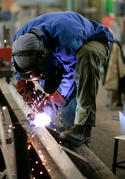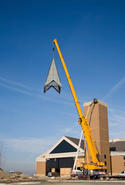What is the real endgame of healthcare debate in Washington? Is it going to be a bailout of the insurance industry as opposed to a plan to provide healthcare for every American? The original jumping off point for this entire debate was that the United States is the only major industrialized country that does not have a national healthcare system. The debate has moved away from “how do you get healthcare” to “how do you get health insurance.” read more »
Yes, Manufacturing Matters
Manufacturing employment has fallen below 12 million jobs for the first time since 1941, and manufacturing jobs as a percentage of total employment has fallen below 9%, the lowest level since the Bureau of Labor Statistics started collecting data in 1939. But annual manufacturing output per worker is also at a record high: $223,915 (in constant 2000 dollars). That's almost 3 times as much output per worker as in the early 1970s, and twice as much output per worker compared to the mid-1980s.
That has been the trend over the last 40 years: more output with fewer workers. That’s a good thing, or inevitable, or both – isn’t it? I used to think so; now I’m not so sure. read more »
Report from Orlando: The Spirit Rocks On
By Richard Reep
“In hard times, people turn to God or alcohol” jokes Bud Johnson of Constructwire, a database that tracks planning and construction projects nationwide. Johnson, 50, is an industry veteran and has never seen a recession like this in his career. “This is an exceptionally broad-based downturn,” he says, “and Orlando has been hit harder than most in the South, what with your only real industries being housing and tourism.” Both industries have been trapped like mammoths in a glacier as the credit market stays stubbornly frozen in a modern banking Ice Age. read more »
- Login to post comments
Let Freedom Ring: Democracy and Prosperity are Inextricably Linked
With autocratic states like China and Russia looking poised for economic recovery, it's often hard to make the case for ideals such as democracy and rule of law. To some, like Martin Jacques, author of When China Rules, autocrats seem destined to rule the world economy. read more »
Executive Bonuses: The Junta In The Boardroom
Public companies and their management boards are run with all the democratic coziness of banana republics. The object of the junta is to transfer the wealth of the shareholders into the bonuses and stock options of the management. As they used to say in China, “business is better than working.”
Amidst the outcry over excessive executive pay, it is worth noting that, in the caudillo management culture of many public corporations, there is nothing more annoying than a shareholder with an interest in the company that he or she partly owns. The most dreaded corporate day of the year is that of the annual meeting, when outside consultants are hired to screen bothersome questions and choreograph the happy gathering. read more »
Property Owners Pay for City’s Dysfunction Under L.A.’s New Graffiti Ordinance
Graffiti is a bane of urban life, a form of vandalism that demoralizes entire neighborhoods and invites worse crime.
Graffiti is an art form and an outlet for expression amid the jumble and obvious strains of urban life.
You’ll hear arguments from both of those viewpoints, depending on who you talk to about graffiti. read more »
- Login to post comments
Fixing the Mortgage Mess: Why Treasury’s Efforts at both Ends of the Spectrum Are Failing
To get a better idea why the Obama Administration’s efforts to stem the home foreclosure crisis have failed at both ends of the problem, you need only go back to that great scene in Frank Capra’s classic, “It’s A Wonderful Life,” where protagonist George Bailey (Jimmy Stewart) is on his way out of Bedford Falls with his new bride and high school crush, the former Meg Hatch (Donna Reed). The newlyweds are heading toward the train station to leave on their honeymoon when Meg notices a commotion outside the Bailey Bros. read more »
Home-Based Businesses: Residential Zoning and The Cyber Village
Currently in the United States about 27% of all homes have some form of a home based business. These businesses can be key to conservation efforts that lower our carbon footprint by reducing transportation needs, eliminating redundant facilities, and consolidating equipment. They provide significant opportunities for two solutions to problems that face today’s growth issues. read more »
The Limits of Transit: Costly Dead-End
The proposed Chicago Transit Authority (CTA) fare increase and service cuts for next year are indicative of transit’s recurring budgetary problems, and not only in Chicago but nationwide. But in the Windy City, these moves have elicited an understandably negative public reaction since the city of Chicago depends on transit about as much as any city besides New York. read more »
Stimulate Yourself!
Beltway politicians and economists can argue themselves silly about the impact of the Obama administration's stimulus program, but outside the beltway the discussion is largely over. On the local level--particularly outside the heavily politicized big cities--the consensus seems to be that the stimulus has changed little--if anything.
Recently, I met with a couple of dozen mayors and city officials in Kentucky to discuss economic growth. The mayors spoke of their initiatives and ideas, yet hardly anyone mentioned the stimulus. read more »





















